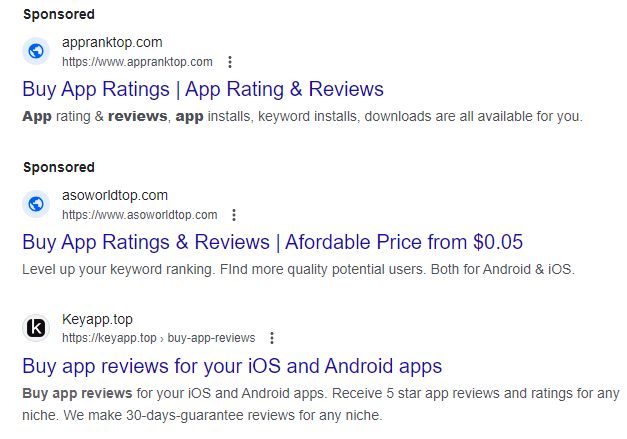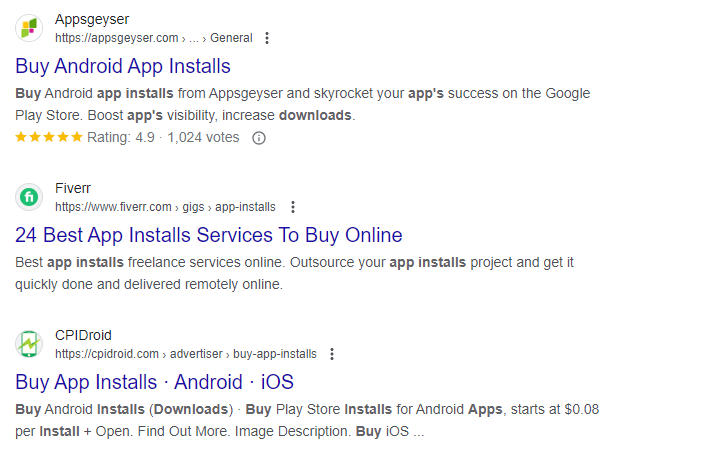What is Black Hat App Store Optimization (ASO)?

Today we are exploring Black Hat ASO and provide a full breakdown of its tactics, detection methods, and penalties.
What Makes Certain ASO Practices Black Hat?
Black hat ASO tactics not only breach the terms of service laid out by app platforms like Apple’s App Store and Google Play but also compromise the integrity of the app ecosystem and erode user trust.
Black Hat ASO aims to exploit the system for quick gains, disregarding the rules and ethical standards that ensure a level playing field for all developers.
This approach contrasts sharply with White Hat app store optimization (ASO), which focuses on improving app quality, relevance, and user experience, aligning with app store guidelines to achieve sustainable growth.
Does Black hat ASO work?
Black hat ASO may work in the short run, but it’s always set to backfire with strong penalties or even permanent bans from the marketplace.
Google and Apple employ several tactics that detect black hat techniques. While app developers and marketers may find short benefits and ranking increases, their suspicious behavior gets detected sooner or later.
What are Black Hat ASO Techniques?
Black hat ASO techniques are unfair manipulative strategies such as buying or influencing ratings and reviews, keyword stuffing, manipulating subscription prices, using bot traffic, faking installations, or tarnishing (or exploiting) competitors.
These methods exploit the algorithms behind app store operations and can significantly distort the app’s perceived value and relevance.
Below are detailed explanations of the most prevalent Black hat ASO practices.
Black Hat ASO Technique 1: Buying or Influencing Ratings and Reviews
This unethical practice involves compensating users or employing services to generate fake reviews and ratings.
When these metrics are artificially inflated, developers create a misleading impression of their app’s quality, potentially deceiving users into downloading an app based on falsified user satisfaction.

Black Hat ASO Technique 2: Keyword Stuffing
This tactic involves overloading app titles, descriptions, and metadata with excessive keywords, especially those that may not be directly relevant to the app’s functionality.
While it may temporarily improve an app’s search visibility, it compromises the user experience by cluttering app listings with irrelevant information, leading to poor user engagement and dissatisfaction.
Black Hat ASO Technique 3: Leaving Negative Reviews on Competitor Apps
In this approach, developers post negative reviews on the listings of competing apps.
The intent is to ruin the competitors’ reputations and mislead potential users. At the same time, the black hast ASO spammers push their app as a superior alternative.
Black Hat ASO Technique 4: Hacking the Top Three Most Helpful Reviews
Manipulating the review system to make certain reviews appear more helpful than they are is another common tactic.
This manipulation involves influencing the review voting system to highlight positive reviews, regardless of their authenticity and artificially enhancing the app’s reputation.

Black Hat ASO Technique 5: Using Competitor Names
Including the names of popular competitors in an app’s keywords or metadata is a deceptive practice. The goal of this tactic is to have a certain app appear in app store search results, even though real users didn’t search for it.
Using competitor names or branding can mislead users searching for specific apps, diverting traffic based on brand recognition rather than app relevance or quality.
Black Hat ASO Technique 6: Manipulating Subscription Prices
Some developers may lower subscription prices initially to attract users and then increase them once a significant user base has been established.
This bait-and-switch tactic can lead to user dissatisfaction and complaints once the price increases take effect.
Black Hat ASO Technique 7: Using Bot Traffic
Deploying bots to download or interact with an app can artificially inflate engagement metrics and rankings. This type of traffic does not represent genuine user interest or engagement and can skew analytical data to gauge an app’s success.
Black Hat ASO Technique 8: Fake Installations
Generating non-authentic installations through software or services is a direct attempt to boost an app’s popularity metrics falsely.
Like bot traffic, these installations do not reflect real user interest and can mislead developers and advertisers about the app’s performance.
Below is an example of companies selling fake app installations in Google directly!

Black Hat ASO Technique 9: Manipulating Top Grossing Charts
Some developers use timed mass purchases or coordinated spending events to propel their apps into top-grossing charts.
While this can temporarily favor an app, it does not sustainably reflect its market performance or user preference.
How Can App Stores Detect and Prevent Black Hat ASO Techniques?
App stores detect and prevent black hat ASO techniques using automated systems, algorithms, human reviews, and community feedback.
These measures are essential to preserve the integrity of the app marketplace and ensure a fair and secure user experience.
Here’s an in-depth look at the primary methods used by app stores to combat these unethical practices
Automated Systems and Algorithms
Both Google Play and the Apple App Store deploy advanced algorithms to spot unusual patterns indicative of black hat ASO activities.
These algorithms scrutinize vast datasets encompassing app downloads, ratings, and user behaviors to identify anomalies that stray from expected patterns. Such monitoring helps in the early detection of potential manipulations, allowing for timely interventions.
App stores continuously scan app metadata, such as titles, descriptions, and keywords.
This keyword and metadata analysis helps identify instances of keyword stuffing or the use of irrelevant but popular keywords to manipulate search algorithms.
App metadata must genuinely represent the app’s content, without using manipulative tactics to enhance visibility. App stores employ algorithms for automated reviews to ensure that only relevant and accurately described apps are visible to users.
We always recommend checking official Apple App Store guidelines and Google Play Store guidelines to be on the safe side.
Human Review and Audits
In addition to automated systems, both app stores have dedicated teams manually reviewing apps.
Manual reviews are particularly true for apps that experience sudden spikes in rankings or surges in reviews over a short period.
The human element in these reviews allows for a nuanced assessment of whether an app employs black hat techniques, such as generating fake reviews or using misleading metadata.
To further ensure compliance with guidelines, app stores regularly conduct random audits.
These audits are designed to catch developers who might temporarily evade detection by automated systems, providing an additional layer of scrutiny that helps maintain the fairness and security of the app ecosystem.
Community Reporting and Feedback
Both Google Play and the Apple App Store encourage and facilitate reports from developers and users regarding suspicious activities or apps that appear to engage in black hat ASO.
This form of community policing helps app stores quickly identify and address potential abuses, enhancing the overall trustworthiness of the marketplace.
User feedback mechanisms play a crucial role in assessing app quality and monitoring the integrity of app metadata and behavior.
Reports from users about apps not performing as advertised or engaging in deceptive practices can prompt a formal review by the app store, leading to corrective actions if necessary.
Through these comprehensive detection and prevention strategies, app stores actively mitigate the impact of black hat ASO practices and protect app developers who play by the rules.
What are the Penalties for Using Black Hat ASO?
Penalties for using black hat ASO include immediate removal or suspension from the marketplace, certain reputation damage, and, in some severe cases, a permanent ban from the marketplace.
The penalties are designed to maintain a fair and trustworthy environment for developers and users.
Here are the primary consequences faced by those who employ these unethical tactics.
Immediate Removal or Suspension
One of the most immediate consequences of being caught using black hat ASO techniques is the potential removal or suspension of an app from the app store.
This action is taken to quickly mitigate any unfair advantage gained and to protect users from potentially deceptive or harmful apps.
The removal or suspension acts as a significant punishment, emphasizing the app stores’ commitment to enforcing their guidelines and maintaining the integrity of their platforms.
Permanent Banning from the Marketplace
App stores may impose permanent bans in cases of particularly severe violations or repeated black hat practices.
The ban is more drastic and prohibits the developer from submitting any new apps or updates for existing apps across the platform.
Such a ban affects the immediate availability of the developer’s apps and their future potential to operate within the app store ecosystem, effectively cutting off a significant channel for user acquisition and revenue.
Reputation Damage
Beyond app stores’ direct actions, developers using black hat ASO techniques also risk severe damage to their reputation.
Reputation damage can manifest in various ways, from user distrust to lower download numbers and engagement and a tarnished reputation within the broader developer community. This also affects potential partnerships and business opportunities.
The long-term impact on a developer’s brand and the trustworthiness of their apps can be far more damaging than any immediate penalties imposed by app stores.
These penalties underscore the risks associated with black hat ASO and highlight why developers must adhere to ethical practices.
Key takeaways on Black Hat ASO
Black hat ASO practices offer tempting shortcuts to boost app visibility and downloads but come with significant risks, including the potential for penalties from app stores, damage to reputation, and loss of user trust.
These techniques undermine fair competition and can degrade the overall quality of the app ecosystem.
Developers are encouraged to stick to ethical ASO practices that deliver genuine user value, ensuring long-term success and sustainability in the app marketplace.
Developers and app marketers must invest in strategies that enhance the user experience and follow app store guidelines.
While “playing by the rules” can be challenging in a competitive market, it’s also rewarding and sustainable in the long run.
right in your inbox.
Latest Academy Lessons

